OVERVIEW OF QUESTIONS AND ANSWERS SERIES
January to June 2001
| January | February | March | April | May | June |
January
January 2001 (Part 1)
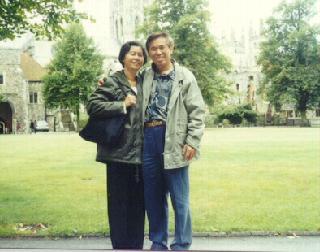
If you treat your wife not as someone who happens to marry you, but someone who is going to spend the best part of her life for your welfare, which is actually the case, and treat your son not just as an incidental outcome of some pleasure, but as a living manifestation of your love and joy, which is also actually the case, you will find spending time with them not a responsibility but a special privilege.
Click here to enter.
January 2001 (Part 2)
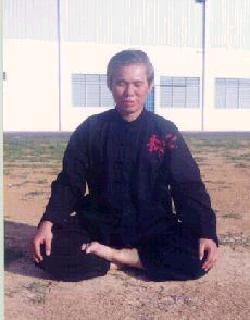
Phenomena are not absolutely real. They are real only in relation to a set of conditions, such as the ways my eyes, ears, nose, and other organs interpret data. Another sentient being, such as a bacterium or a fairy, would interpret the same data very differently. A bacterium or a fairy would not experience any chair, keyboard, breeze, singing or fragrance the way we humans experience these phenomena. In other words, in the same space and at the same time, different beings experience phenomenal reality differently.
Click here to enter.
January 2001 (Part 3)
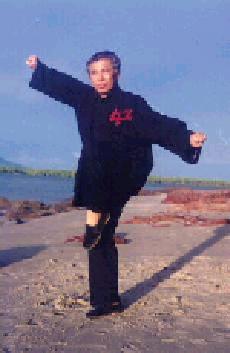
When the attacker bends forward to grab the defender's legs, all the defender needs to do to main or even kill the attacker is to move one leg back into a bow-arrow stance and simultaneously drive a punch into the attacker's head. Even if the attacker has initially poked his palm jab into the defender's eye and has grabbed the defender's legs, in close quarter and with the attacker's two hands indisposed, fighting for life or vengeance the defender could easily tear out the attacker's throat. Although a Shaolin disciple would not use such drastic, destructive counters, he always makes sure his opponent has no chance to use these counters on him.
Click here to enter.
February
February 2001 (Part 1)

My intensive chi kung course is complete by itself. This means that a dedicated student, without any prior knowledge and experience of chi kung, and without learning anything extra from me or elsewhere, can competently practise on his own after the course and attain a fairly high level and may eventually become a master.
Click here to enter.
February 2001 (Part 2)
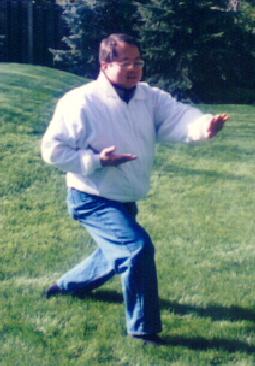
Many people may say they know what "never easy" means, but when they stand at their stance for only ten seconds when they are required to stand for fifteen minutes, or when perform their moves only once when they are told to perform fifty times, they do not know what "never easy" means.
Click here to enter.
February 2001 (Part 3)
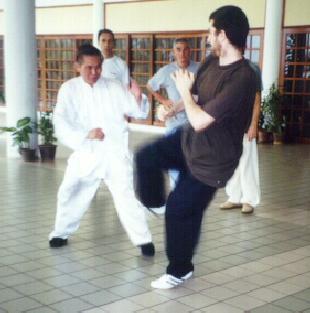
Nevertheless, if all other things were equal, one particular style may be superior to another. For example, a style that employs internal force is superior to one that uses only mechanical strength. A style that employs all modes of attacks -- such as strikes, kicks, throws and grips -- is superior to one that mainly uses only one mode, like only throws or only kicks. However, an expert in an inferior style would be a better fighter than a novice in a superior style.
Click here to enter.
March
March 2001 (Part 1)
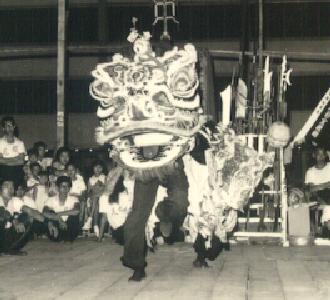
Even if the Taiji student had a lot of time and patience, after twenty years dancing he would still be no match against a Taekwondo or Western Boxing student who had trained for just six months. But if he trains genuine Taijiquan instead of Taiji dance for six months, he can be as equally combat effective as his Taekwondo or Western Boxing counterpart.
Click here to enter.
March 2001 (Part 2)

Health, or yin-yang harmony, is natural. This means without having to do anything, a person -- any person -- is healthy. He (or she) loses this natural state when one or more systems in his body (and mind) fail to function naturally. Sickness, or yin-yang disharmony, is unnatural. Because it is unnatural, sickness -- irrespective of the different names people may label its countless symptoms -- is only temporary and can be rectified. One excellent way to restore yin-yang harmony is practising genuine chi kung.
Click here to enter.
March 2001 (Part 3)

But chi kung is different. What are involved are mind and energy, the external form serving as a vehicle. In physical exercise, when you move a hand, you move a hand. In chi kung, when you move a hand, you use this movement to manage mind and energy. Even if you have the skill to manage energy by moving your hand (the first skill), you still do not have the (second) skill to teach this (first skill) to others.
Click here to enter.
April
April 2001 (Part 1)
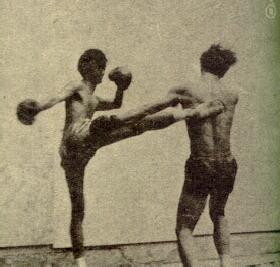
I remember very clearly my master, Sifu Ho Fatt Nam, once asked me, "How would a gentle woman fight with a fierce and powerful Siamese kickboxer? How would she block his sweeping kicks, for example?"
Click here to enter.
April 2001 (Part 2)
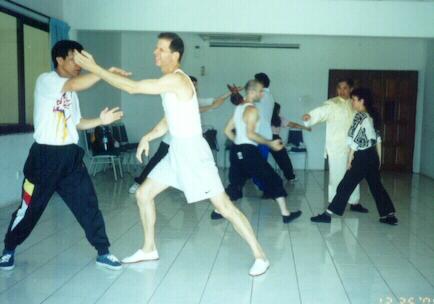
A very big difference between eastern medicine and modern western medicine, although this difference is often under-estimated, is that eastern medicine as well as ancient and medieval western medicine treat man with a soul or psyche, whereas modern western medicine treats man with only a physical body.
Click here to enter.
April 2001 (Part 3)

Jin is the usual term in kungfu to refer to internal force, in contrast to li which refers to muscular strength. A principle tenet of kungfu, especially internal kungfu, is to use jin and not li . Those who are unfamiliar with these Chinese terms are puzzled by expressions commonly found in internal art training like "Don't use strength and you will get a lot of strength". What is meant is "Don't use muscular strength (in internal training) and you will get a lot of internal force."
Click here to enter.
May
May 2001 (Part 1)
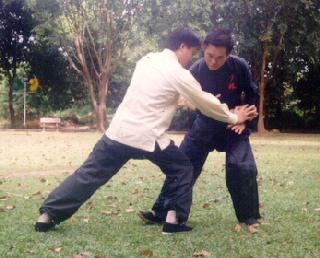
As a genuine Shaolin or Taijiquan practitioner you would have much internal force and be effective in using Shaolin Kungfu or Taijiquan for combat. More importantly, you would be healthy, full of vitality, mentally fresh, and spiritually joyful.
Click here to enter.
May 2001 (Part 2)
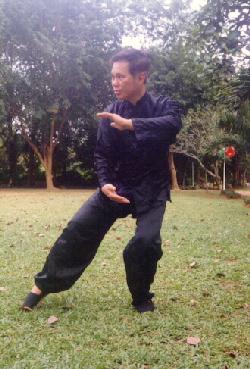
The difference between performing it as a physical exercise and as a chi kung exercise cannot be easily described in words or pictures. That is one of many reasons why one should practise chi kung from a competent instructor who himself can perform chi kung. If you have performed chi kung, you would have no difficulty telling the difference.
Click here to enter.
May 2001 (Part 3)
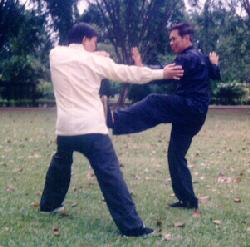
Taijiquan is indeed wonderful. Not only its very effective combat applications are graceful and gentle -- far from the brutality of many other martial arts -- its training as a martial art brings good health, vitality and spiritual joy -- whereas many other martial arts are detrimental to health, wear down your energy, and may make you hostile and aggressive.
Click here to enter.
June
June 2001 (Part 1)
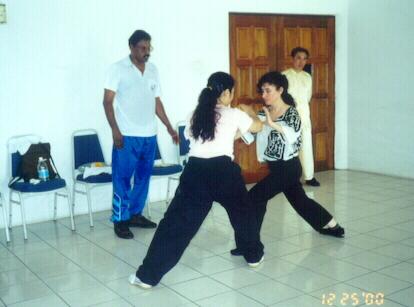
If you examine classical kungfu literature recording how kungfu was practised in the past, you would find that set practice, i.e. learning kungfu form, constituted only a small part of the training programme. For an exponent who had spent 10 years in kungfu training, the first year would be spent on learning kungfu form, and the remaining nine years on force training and sparring.
Click here to enter.
June 2001 (Part 2)
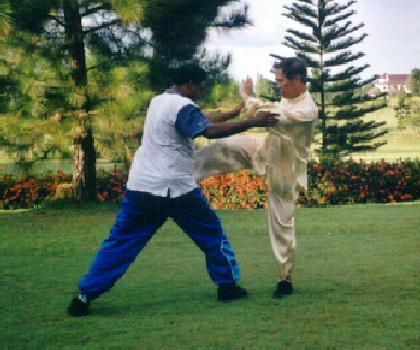
Eastern masters also have a different perspective regarding mind training. Being able to think out good answers to any questions is the effect of a trained mind, and not as in the case of the Western perspective above, its cause. In other words, a person trains his mind first, then he becomes efficient in thinking. The paramount approach to mind training is meditation. In the Western perspective, it is reversed -- a persons uses thinking to train his mind.
Click here to enter.
June 2001 (Part 3)
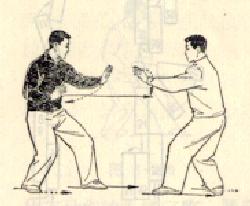
According to the Chinese medical paradigm, there is only one illness, namely yin-yang disharmony, although there may be countless symptoms. Yin symbolizes your body's adjustment to constantly changing environment inside and outside your body. Yang symbolizes all the factors that cause changes which may lead to illness.
Click here to enter.
